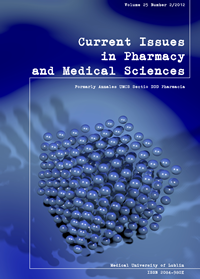Neurological complications of temporal arteritis – a case report
DOI:
https://doi.org/10.12923/j.2084-980X/25.2/a.25Keywords:
giant cell arteritis, temporal arteritis, treatment, prognosis, neurological complications, visual loss, strokeAbstract
The pathophysiology of giant cell arteritis (temporal arteritis) is not fully understood. The disease frequently presents itself with nonspecific complaints like headache, low-grade fever of the unknown origin. The most severe complications of giant cell arteritis include blindness and cerebrovascular incidents. The diagnosis is based on the occurrence of certain factors including age above 50 years and positive results of a temporal artery biopsy. The administration of corticosteroids remains the only proven way of treatment for giant cell arteritis so far. This report presents a case of a patient with temporal arteritis who presented such neurological complications as loss of vision and brain ischemia. A 74 year-old female was admitted to the hospital in Sanok complaining about weakness lasting for about two weeks. She also reported low-grade fever, headache, tenderness, and inflammation along the course of the temporal arteries and bilateral blurred vision (stronger in the right eye). She also complained about jaw and tongue claudication and taste loss. Based on the literature, if giant cell arteritis is suspected, the treatment with glucocorticoids should be initiated promptly to prevent neurological complications.
References
1. Chan M, Lugmani R: Pharmacotherapy of vasculitis. Expert Opin. Pharmacother., 10, 1273, 2009.
2. Chansson N et al.: Bilateral intracerebral angioplasty in a patient with stroke caused by giant cell arteritis. Rev. Neurol. (Paris), 166, 328, 2010.
3. Kermani TA, Warrington KJ: Recent advances in diagnostic strategies for giant cell arteritis. Curr. Neurol. Neurosci. Rep., 12, 138, 2012.
4. Moroianu C et al.: Fatal giant cell arteritis with severe bilateral involvement of the vertebral arteries. Rev. Neurol. (Paris), 162, 876, 2006.
5. Pfadenhauer K, Roesler A, Golling A: The involvement of the peripheral nervous system in biopsy proven active giant cell arteritis. J. Neurol., 254, 751, 2007.
6. Rozwodowska M, El-Essa A, Kubica J: Olbrzymiokomórkowe zapalenie tętnic (zapalenie tętnicy skroniowej). Opis 2 przypadków. Choroby Serca i Naczyń, 3, 211, 2006.
7. Samson M, Bonnotte B: Giant-cell arteritis pathogenesis. Presse Med., 2012 Aug 14. [Epub ahead of print]
8. Schmidt D, Vaith P, Hetzel A: Prevention of serious ophthalmic and cerebral complications in temporal arteritis? Clin. Exp. Rheumatol., 18 (Suppl 20), 61, 2000.
9. Wiszniewska M, Członkowska A: Rola zapalenia naczyń w etiologii udaru mózgu. Udar mózgu, 10, 8, 2008.
10. Zamarbide ID, Maxit MJ: Fisher’s one and half syndrome with facial palsy as clinical presentation of giant cell temporal arteritis. Medicina (B Aires), 60, 245, 2000.
Downloads
Published
Issue
Section
License
Copyright (c) 2012 Authors

This work is licensed under a Creative Commons Attribution-NonCommercial-NoDerivatives 3.0 Unported License.


